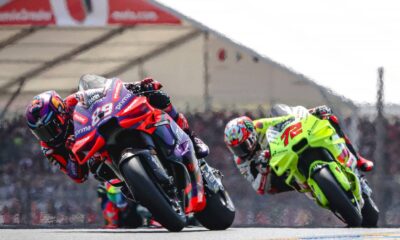Football
Tactical review: Manchester United vs. Crystal Palace | Rangnick brings new 4222 system to the Premier League
Ralf Rangnick has had his first game in the hot seat at Old Trafford. His charges beat Crystal Palace 1-0 and shone with a great performance especially in the first half. After just a few days in the job, the German coach’s handwriting is more than evident at the Red Devils.

Ralf Rangnick has had his first game in the hot seat at Old Trafford. His charges beat Crystal Palace 1: 0 and shone with a great performance especially in the first half. After just a few days in the job, the German coach’s handwriting is more than evident at the Red Devils.
Lineups
Manchester United formed into the currently unused formation 4222 in the Premier League. In attack were the pair of spike strikers Rashford and Ronaldo, below them in the position of ten Sancho and Fernandes and the defensive midfielders were the unpopular pair of McTominay and Fred.
Telles and Dalot played in the wing-back position, while the stopper duo was formed by Lindelöf and Maguire. Crystal Palace went with a 433 formation, occasionally 4231 with Schlupp as the more advanced of the Kouyaté – Gallagher – Schlupp triplet.
Manchester United | Build-up
The home side spent most of the time with the ball, which was exchanged between the players 557 times during the game. Fred was the most active in this regard, with 72 passes, twice as active as his teammate McTominay. Both midfielders were key players for United in transition, which shows the impact of their activity in certain parts of the pitch.
Fred was a left-sided pivot, which led to more than 50% of the action through the left side of the pitch. Left back Telles also had 1.5 times more passes than Dalot playing on the opposite side. It was these two positions (left/right midfielder and fullback), along with the offensive midfielder on that side, that were key to United’s interplay.
The home side permeated the London outfit’s defences mainly through the flanks. The stoppers were not trying to break Palace’s front line with their passing, but rather passing to the by-line.
Whenever the ball reached Telles, Fred and the left sub (Sancho or Fernandes) came on immediately. This trio formed a triangle and often outnumbered the opposition in it. If the right-back Clyne stepped up to it, it opened up space for Rashford to run in.
It was his speed on long passes that either Telles or Lindelöf used extensively. But the England international was not so good at timing his runs. He took care of all the offsides for both teams in Sunday’s game.
When the aforementioned trio formed a triangle, the other pivot (in this case McTominay) held the pivot, to which the second ten also retreated. The remaining three attacking players Dalot, Ronaldo and Rashford offered runs behind the defence, but the former still held the width of play.
The trio of Telles, Fred, Fernandes also often followed the pass and run motto, with the Brazilians in particular often passing the ball to the more technically gifted Bruno and immediately sprinting forward. It was also interesting to watch Lindelöf’s forays, often deputising for the forward charging sub in the triangle on the right.
Manchester United | Presink
The biggest expectations were after the announcement of Rangnick’s arrival on his domain – presink. He was more than bad under Ole Gunnar Solskjær, so the instant rise in the very first game was certainly a treat for Red Devils fans.
The 4222 formation, which was maintained even on the press, was crucial in helping to cut off the midfield that United were aiming for. They left completely open the spaces between the spaced-out stoppers and the drawn-out flankers, where Crystal Palace beckoned. When the ball got to the wing, they pressured their opponents into a seemingly safe pass back to the stoppers.
And it was these back passes that Rangnick’s charges were waiting for. The strikers immediately set off to meet the recipient of the pass, who often still tried to deal with the situation constructively and pass the hot potato to the other stopper. The second striker was already rushing at him, and the pass to the outside-back was already being read by either the right-back or the defensive midfielder, and that was where the Red Devils players were getting most of the balls.
Manchester United | Attacking phase
Where United managed to get the ball close to the opposition goal, the system was somewhat simple. At the same time, the low experience of the players with Rangnick’s tactics went most evident in such situations.
The width of the pitch was kept by the outside backs, the wingers often retreating closer to the centre line in order to increase the gap between them and the wingbacks. This either stretched the defensive four or kept it too close. So the system ended up looking like 2224.
If the centre of gravity of the game shifted to one side, one defensive midfielder and one sub usually held the centre of the pitch in a similar way. The latter, however, often complemented the spike strikers in the run-up to the centres, to whom the players at the touchlines were not afraid to send one ball after another, even from a greater distance.
The width was kept on the other side by the other extreme defender. In the event of a quick transfer of play, the advantageous positioning meant that the players on the axis could immediately charge him, and the closer of the two tip forwards could likewise run down. It was in these situations that the more distant sub was often faced with the decision of whether to close down the back post in the goal area when a possible centre or to move and hold the centre line.
Whoscored , Premier League

-
Motorsport7 days ago
Jorge Martín is rewriting history! the 26-year-old Spaniard became the new MotoGP World Champion, Bagnaia succumbed despite his best efforts
-
Football17 hours ago
Manchester City blast. Tottenham blew it 4-0, defence on fire
-
Football22 hours ago
Chelsea consolidated third place. Enzo Fernández scored a goal and an assist to help Chelsea win at Leicester















